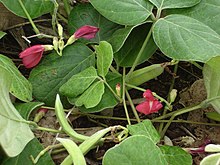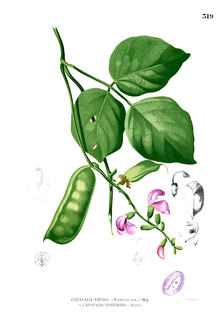Canavalia
| Canavalia | |
|---|---|

| |
| Canavalia sericea | |
| Scientific classification | |
| Kingdom: | Plantae |
| Clade: | Tracheophytes |
| Clade: | Angiosperms |
| Clade: | Eudicots |
| Clade: | Rosids |
| Order: | Fabales |
| Family: | Fabaceae |
| Subfamily: | Faboideae |
| Tribe: | Diocleae |
| Genus: | Canavalia DC.[1] |
| Species[1] | |
|
62; see text | |
| Synonyms[1] | |
| |
Canavalia is a genus of plants in the legume family (Fabaceae) that comprises approximately 62 species of tropical vines.[1] Members of the genus are commonly known as jack-beans. It has a pantropical distribution.[1]
The species of Canavalia endemic to the Hawaiian Islands were named ʻāwikiwiki by the Native Hawaiians. The name translates to "the very quick one"[2] and comes from the Hawaiian word for "fast". The genus name is derived from the Malabar word for the species, kavavali, which means "forest climber."[3]
Uses
Several species are valued legume crops, including common jack-bean (C. ensiformis), sword bean (C. gladiata) and C. cathartica. At least the first makes a beneficial weed- and pathogen-suppressing living mulch.[4] The common jack-bean is also a source of the lectin concanavalin A, which is used as a reagent in glycoprotein biochemistry and immunology. The jack-bean is also a common source of purified urease enzyme used in scientific research.
The bay bean (Canavalia rosea) is supposedly mildly psychoactive when smoked, and is used in tobacco substitutes.
Ecology
Some animals have adaptations to the defensive chemicals of jack-beans. Caterpillars such as that of the two-barred flasher (Astraptes fulgerator) are sometimes found on Canavalia. The plant pathogenic ascomycete fungus Mycosphaerella canavaliae was described from a jack-bean. Introduced herbivores have wreaked havoc on Canavalia on the Hawaiian Islands and made some nearly extinct; it may be that these lost their chemical defenses because no herbivorous mammals existed in their range until introduced by humans. The usually bright pea-flowers are pollinated by insects such as solitary bees and carpenter bees such as Xylocopa confusa.
History
The genus name Canavalia was, as recently as 1913, known as Canavali.[5]
Diversity


Species include:[6]
- Canavalia acuminata Rose
- Canavalia africana Dunn
- Canavalia altipendula (Piper) Standl.
- Canavalia aurita J.D. Sauer
- Canavalia bicarinata Standl.
- Canavalia boliviana Piper
- Canavalia bonariensis Lindl.
- Canavalia brasiliensis Mart. ex Benth.[7] – Barbicou-bean, feijão-bravo do Ceará (Brazil)
- Canavalia campylocarpa Piper
- Canavalia cathartica Thouars (syn. C. virosa (Roxb.) Wight & Arn.)
- Canavalia centralis H.St.John
- Canavalia concinna J.D.Sauer
- Canavalia dolichothyrsa G.P. Lewis
- Canavalia dura J.D. Sauer
- Canavalia ensiformis (L.) DC. – common jack-bean, giant stock-bean, gotani-bean, horse-bean, seaside-bean, wonder-bean, feijão-de-porco (Brazil)
- Canavalia eurycarpa Piper
- Canavalia forbesii H.St.John
- Canavalia galeata (Gaudich.) Vogel[8] (Oʻahu)[9]
- Canavalia glabra (M. Martens & Galeotti) J.D.Sauer
- Canavalia gladiata (Jacq.) DC. – sword bean, scimitar-bean
- Canavalia grandiflora Benth.
- Canavalia haleakalaensis H.St.John
- Canavalia hawaiiensis O.Deg., I.Deg. & J.D.Sauer[8]
- Canavalia hirsutissima J.D. Sauer
- Canavalia iaoensis H.St.John
- Canavalia kauaiensis J.D.Sauer[8]
- Canavalia kauensis H.St.John
- Canavalia lineata (Thunb.) DC.
- Canavalia macrobotrys Merr.
- Canavalia macropleura Piper
- Canavalia madagascariensis J.D.Sauer
- Canavalia makahaensis H.St.John
- Canavalia mattogrossensis (Barb. Rodr.) Malme
- Canavalia matudae J.D. Sauer
- Canavalia microsperma Urb.
- Canavalia mollis Wight & Arn.
- Canavalia molokaiensis O.Deg., I.Deg. & J.D.Sauer[8] – Molokaʻi jack-bean
- Canavalia munroi (O.Deg. & I.Deg.) H.St.John
- Canavalia napaliensis H.St.John[8] – Mākaha Valley jack-bean
- Canavalia nitida (Cav.) Piper – Cathie's bean
- Canavalia nualoloensis H.St.John
- Canavalia obidensis Ducke
- Canavalia oxyphylla Standl. & L.O. Williams
- Canavalia palmeri (Piper) Standl.
- Canavalia papuana Merr. & L.M. Perry
- Canavalia parviflora Benth.
- Canavalia peninsularis H.St.John
- Canavalia picta Benth.
- Canavalia piperi Killip & J.F.Macbr.
- Canavalia plagiosperma Piper – giant bean, oblique-seed jack-bean
- Canavalia pubescens Hook. & Arn.[8] – lavafield jack-bean
- Canavalia raiateensis J.W. Moore
- Canavalia ramosii J.D. Sauer
- Canavalia regalis Piper & Dunn
- Canavalia rockii H.St.John
- Canavalia rosea (Sw.) DC. – bay bean, beach-bean, coastal jack-bean, fire-bean, Mackenzie-bean
- Canavalia rutilans DC.
- Canavalia sanguinea H.St.John
- Canavalia saueri Fantz
- Canavalia septentrionalis J.D. Sauer
- Canavalia sericea A. Gray
- Canavalia sericophylla Ducke
- Canavalia stenophylla H.St.John
- Canavalia villosa Benth.
Formerly placed here
- Dysolobium grande (Wall. ex Benth.) Prain (as C. grandis (Wall. ex Benth.) Kurz)[7]
Gallery
See also
- Thierry Bardini - researched Venezuelan jack-bean agriculture early in his career
References
- ^ a b c d e Canavalia DC. Plants of the World Online. Retrieved 14 August 2023.
- ^ Pukui, M. K., et al. (1992): New Pocket Hawaiian Dictionary with a Concise Grammars and Given Names in Hawaiian. University of Hawaii PRess, Honolulu. ISBN 0-8248-1392-8
- ^ Austin, D. F. (2004). Florida Ethnobotany. CRC Press. p. 161. ISBN 978-0-8493-2332-4.
- ^ Caamal-Maldonado, J. A.; et al. (2001). "The use of allelopathic legume cover and mulch species for weed control in cropping systems". Agronomy Journal. 93: 27–36. doi:10.2134/agronj2001.93127x. Archived from the original on 2014-05-25. Retrieved 2013-08-29.
- ^ Piper, C. V. 1913. "The Jack Bean and the Sword Bean." USDA Bureau of Plant Industry, Circular. No. 110. p. 29-36
- ^ Genus Canavalia. Archived 2014-05-17 at the Wayback Machine International Legume Database & Information Service (ILDIS). Version 10.01, November 2005. Retrieved 17 December 2007.
- ^ a b "GRIN Species Records of Canavalia". Germplasm Resources Information Network. United States Department of Agriculture. Archived from the original on 2009-01-20. Retrieved 2010-12-03.
- ^ a b c d e f "ʻawikiwiki, puakauhi". Hawaiian Ethnobotany Database. Bernice P. Bishop Museum. Archived from the original on 2007-07-02. Retrieved 2009-03-26.
- ^ "Canavalia galeata". Hawaiian Native Plant Propagation Database. University of Hawaiʻi at Mānoa. Retrieved 2009-03-26.
External links
- Webarchive template wayback links
- Articles with short description
- Short description is different from Wikidata
- Articles with 'species' microformats
- Commons category link from Wikidata
- Taxonbars with 20–24 taxon IDs
- Articles with J9U identifiers
- Canavalia
- Fabaceae genera
- Taxa named by Michel Adanson
- Pantropical flora




